
News
 Back to news
Back to newsThe Most Indestructible Easter Eggs
Tuesday, 19 March 2024As Easter approaches, many people are hunting for the perfect Easter eggs to share with their loved ones – experts predict UK consumers will spend just under £1 billion on Easter chocolates this year.
Nowadays, many people choose to send their loved ones Easter eggs rather than gift them in person. But, despite brands offering a wide range of chocolates, many chocolate eggs, along with their packaging, aren’t durable enough to be transported over long distances. In recent years, this has seen shoppers sharing their disappointment over their treats arriving broken, melted and even mouldy.
So, we decided to investigate which Easter eggs are the most resilient and least likely to suffer damage in transit – to ensure no one is left disappointed on Easter morning.
The study analysed a variety of 10 of the most popular Easter egg products, including the amount of recyclable and non-recyclable packaging, to determine which eggs are the most likely to sustain damage during transit and which are likely to arrive crack-free.
While thick, cushioned packaging can help shield delicate chocolate shells from bumps and jostles, the study revealed that extra packaging isn’t a guarantee that the egg won’t be broken in transit.
PACK & SEND analysts dropped each egg from a height of 5m and 10m to determine which eggs were most likely to survive a bumpy journey.
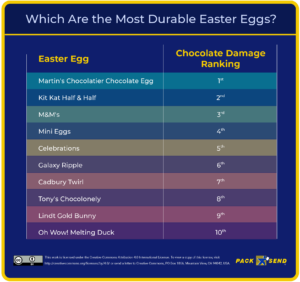
The most durable chocolate egg in the study was the Martins Chocolatier Easter Egg, which remained intact and uncracked even after a 10m drop. At £17.75, this egg was the most expensive in the study, had one of the largest packages (165g) and one of the highest packaging-to-egg ratios to protect it from the drop. This additional packaging fared well, highlighting that the egg is bound to survive even the bumpiest of journeys.
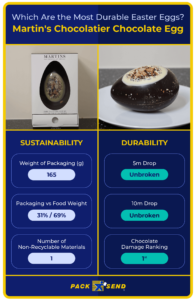
The second most durable Easter egg was the KitKat Chunky Milk & White Chocolate Giant Easter Egg, which managed to sustain the 5m drop without breaking but cracked in half during the 10m drop. At 70g, this package was smaller than average (86g) and had a very low packaging-to-egg ratio, with the packaging weight making up just 23 percent of the total packaging weight.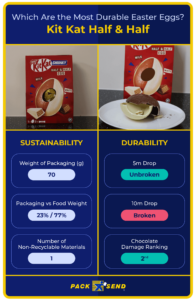
The M&M’s Crispy Large Easter Egg was ranked the third most durable during testing. It was among the smallest eggs in the study, weighing 66g, but its packaging-to-food ratio is among the highest. Twenty-six percent of its total weight is the packaging. However, this extra packaging was not able to completely protect it. While the egg survived a drop from 5m, it suffered considerable damage in the 10m drop.
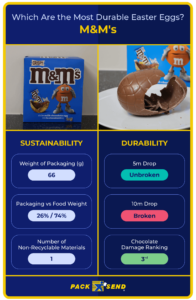
However, not all products have ‘eggcellent’ packaging to protect them from damage in transit. The Easter chocolate, Oh Wow! Melting Duck, was the most prone to damage, breaking almost immediately. It was the smallest among the chocolates tested, which may have contributed to its breakability.
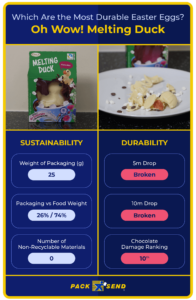
The Lindt Gold Bunny Easter Chocolate also did not fare well, breaking during the initial 5m drop. This is the second smallest package in the study, weighing just 53g. Its packaging-to-food ratio is also higher than the average (27%), as 29 percent of its total weight is from its packaging. However, this extra packaging failed to add extra protection.
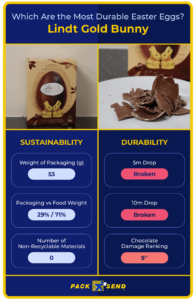
Tony’s Chocolonely Easter Egg, the second most expensive chocolate in the study at £17.50, also didn’t fare well in the drop. At 190g, this product was by far the biggest overall. It also has the largest packaging-to-food ratio, with 43 percent of its weight from packaging. But despite the extra packaging materials, the egg broke on the first 5m drop.
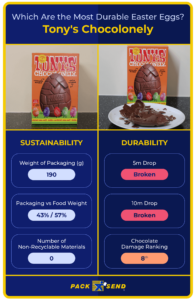
It was interesting to discover no clear pattern or relationship between the amount/type of packaging and the amount of damage to the chocolate. Some products with high packaging weight did well, while other products with a high packaging weight fared poorly.
To round up the rest of the results, in positions 4-7 in terms of damage were Mini Eggs, Celebrations, Galaxy Ripple, and Twirl.
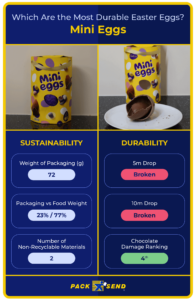

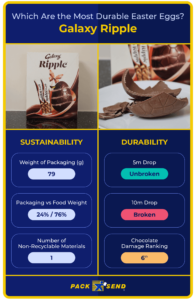
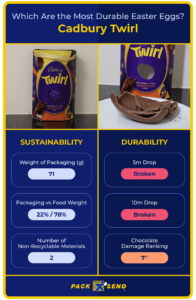
One conclusion we can perhaps draw is that large weighty packaging is rarely necessary and still an area that can be improved in terms of sustainability. The properties of the chocolate inside seemed to have the most influence on how breakable it was, with the packaging having less influence. With that in mind, we might see less unneeded packaging being used on Easter eggs in future, as companies continue to improve their sustainability.
While good packaging is essential for ensuring that the Easter eggs arrive at their final destination intact, it’s also important to ensure that these packaging materials are recyclable to reduce waste. Of the ten products studied, seven contained non-recyclable materials. Three of these packages contained at least two non-recyclable items.
PACK & SEND Head of Marketing, Graeme Rhodes, commented:
“As Easter approaches and consumers begin purchasing their Easter chocolates, it’s crucial to consider the resilience of these treats during transit. Our study underscores the importance of robust packaging to preserve the integrity of Easter eggs, ensuring they arrive at their destination intact.
For those looking to send Easter eggs to their loved ones around the world, it’s worth considering which options are the least likely to be damaged to avoid any unhappy children come Easter.”
Methodology
We put our Easter eggs (and duck) to the test, first dropping them, one-by-one, in an upright position from five metres, followed by a second five-metre drop in a horizontal position. Finally, we gave our eggs (and duck) one single drop from a daunting ten metres.
After each drop, we gave the eggs ‘the rattle test’ to assess whether they had remained intact or not. After the final round of drops, we removed the eggs from the packaging to assess the final damage. Our analysts then ranked each egg from 1-10 (least to most damaged).
We also measured the packaging – first, by weighing the entire product, before weighing the chocolate contents. Using these figures, we calculated the weight of the packaging, as well as ratio of packaging to chocolate.
